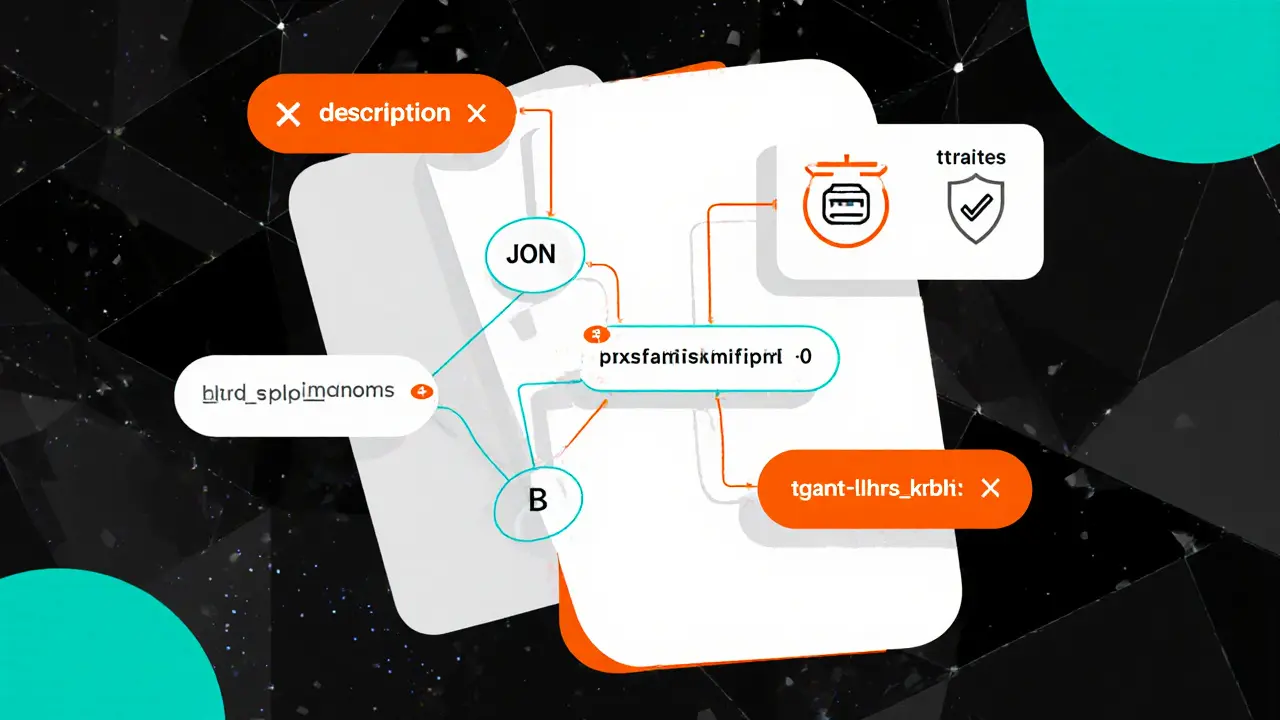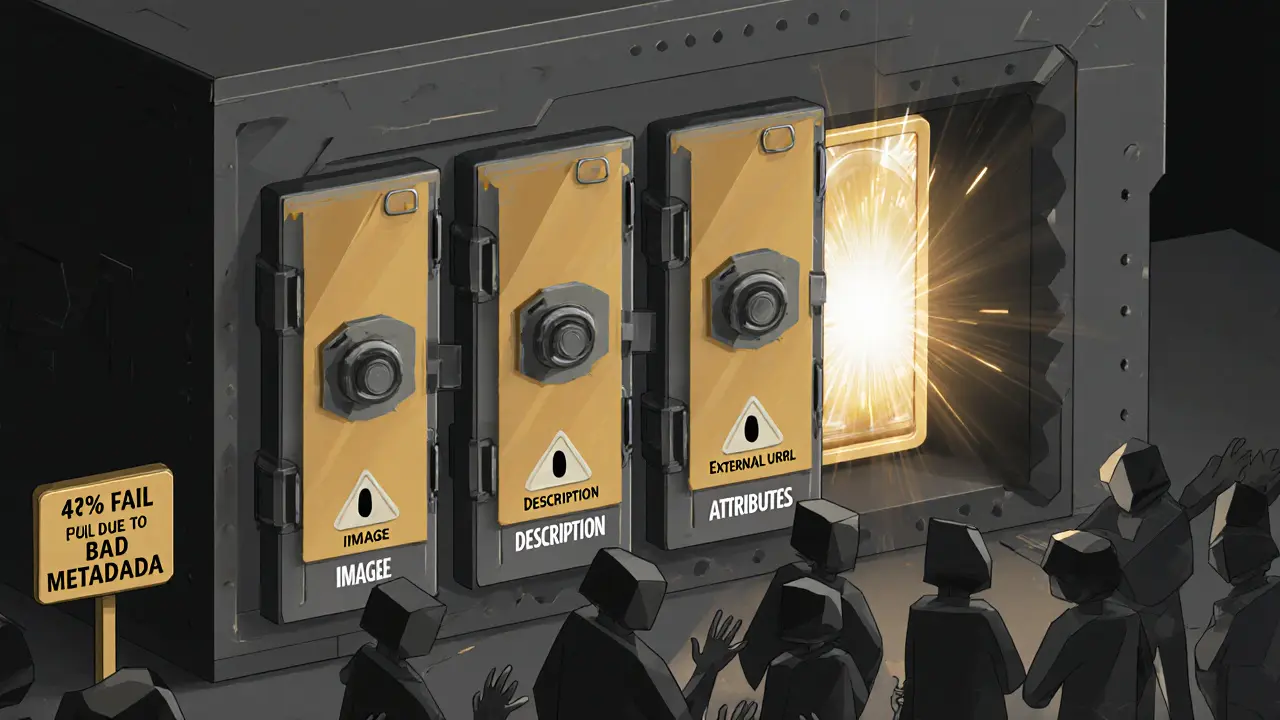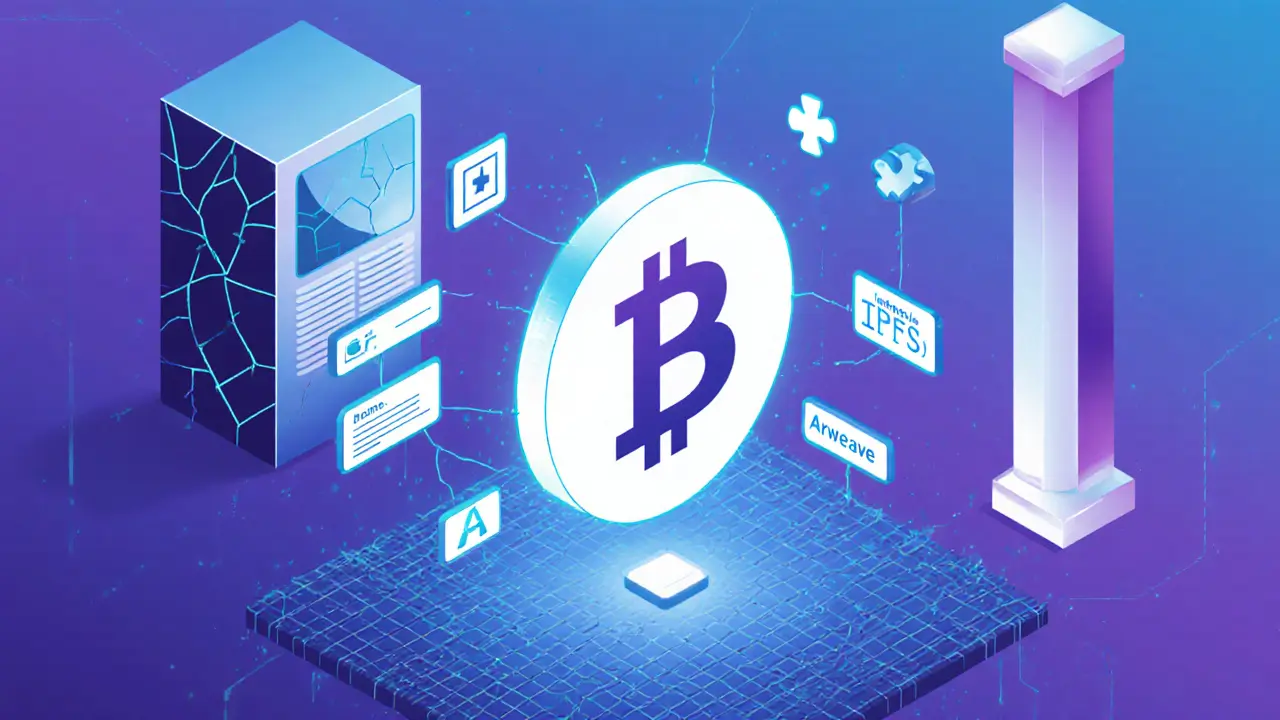NFT Metadata Validator
NFT Metadata Validator
Check your NFT metadata for common errors before minting. This tool verifies required fields, URL formatting, and JSON structure.
Validation Errors Found
Fix these issues before minting your NFT:
Valid Metadata!
Your metadata passes all validation checks. Good to go!
What NFT Metadata Actually Is (And Why It Matters More Than You Think)
Most people think an NFT is just a picture or a collectible token. But that’s not the whole story. The real power of an NFT isn’t in the token itself - it’s in the NFT metadata. This is the hidden data that tells your NFT what it looks like, what it’s called, what traits it has, and where to find its image or animation. Without proper metadata, your NFT is just a string of numbers on a blockchain - useless to buyers, marketplaces, and wallets.
Imagine buying a rare baseball card. You don’t just care about the physical card - you care about the player’s name, stats, team, year, and condition. NFT metadata does the same thing for digital assets. It’s the description, the attributes, the image link - everything that makes your NFT valuable and recognizable. OpenSea found that NFTs with complete metadata sell 47% more often than those without. And according to OpenSea co-founder Alex Atallah, properly structured metadata can make the difference between an NFT selling for 0.1 ETH or 10 ETH.
The Core Fields Every NFT Metadata File Must Have
Every NFT metadata file is a JSON object - a simple text format that computers can read easily. While the exact requirements vary slightly by blockchain, there are five core fields that appear in almost every valid NFT metadata file:
- name: The title of your NFT. OpenSea limits this to 50 characters. Don’t use “#1234” - use “Bored Ape #1234: Laser Eyes”.
- description: A short explanation of your NFT. You can use Markdown for bold, italics, and line breaks. Avoid spammy text like “Buy now!” - keep it factual and engaging.
- image: A direct URL to the main image file. Must be absolute (https://example.com/image.png), not relative (/image.png). The recommended size is 350x350px minimum, but high-end art NFTs often use 5,200x5,200px.
- external_url: A link to your project’s website, Discord, or additional info. This helps buyers learn more about your collection.
- attributes: An array of traits that define your NFT’s features. Each trait has a trait_type (like “Eyes” or “Clothing”) and a value (like “Laser Eyes” or “Bape Jacket”). Optional: display_type can be set to “number”, “boost_percentage”, or “date” to help wallets render values correctly.
These five fields are the bare minimum. But if you want your NFT to show up right on OpenSea, Blur, or Magic Eden, you need more. OpenSea’s 2024 guidelines recommend 12 fields total - and 89% of successful Ethereum collections follow this standard.
On-Chain vs. Off-Chain: Where Your Metadata Lives
Your NFT’s token ID lives on the blockchain - that’s permanent. But the metadata? Most of the time, it’s stored off-chain. That means it’s hosted on a server, not on the blockchain itself. This is a big deal because it affects your NFT’s long-term survival.
There are three main ways to host metadata:
- HTTP (Centralized): 38.2% of NFTs use regular web servers like AWS S3 or Cloudflare. Cheap and easy, but if the server goes down, your NFT image disappears. The DigitalDreams project lost 92% of its value when their HTTP host shut down in 2023.
- IPFS (Decentralized): 59.1% of NFTs use IPFS - a peer-to-peer network that stores files across many computers. It’s much more durable. But you need to “pin” your files (keep them hosted) using services like Pinata or Infura. Pinata charges $0.004 per GB/month for the first 10TB.
- Arweave (Permanent): Only 2.7% of NFTs use Arweave, but it’s the most future-proof. You pay once (around $0.01 per KB) and your data lives forever. Ideal for high-value art and long-term collections.
On Solana, things are different. The Metaplex standard lets you store more data directly on-chain. This makes metadata retrieval faster and eliminates link rot, but it costs more per transaction - $0.00025 on Solana vs. $1.20-$5.00 on Ethereum during busy times.

How Different Blockchains Handle Metadata
Not all NFT standards are the same. Here’s how the big players compare:
| Blockchain | Standard | Metadata Storage | Key Fields | Avg. Cost to Mint | Adoption Rate |
|---|---|---|---|---|---|
| Ethereum | ERC-721 | Off-chain (URI) | name, description, image, attributes | $1.20-$5.00 | 68% of all NFTs |
| Ethereum | ERC-1155 | Off-chain (URI) | Same as ERC-721, supports batch minting | $1.50-$6.00 | 78% of blockchain games |
| Solana | Metaplex v2.1 | Hybrid (some on-chain) | name, description, image, animation_url, properties, collection, uses | $0.00025 | 94.7% of Solana NFTs |
| Binance Smart Chain | BEP-721 / BEP-1155 | Off-chain (URI) | Identical to Ethereum standards | $0.03 | 12% of NFTs on BSC |
| Ronin | ERC-721 + Enjin | Off-chain (URI) | Requires animation_url for gaming assets | $0.01 | Used by Axie Infinity |
ERC-721 is the original standard, but ERC-1155 is taking over for games because you can mint hundreds of NFTs in one transaction. Solana’s Metaplex is growing fast because of speed and low cost - and because it reduces the risk of metadata decay. OpenSea’s metadata format has become the unofficial global standard, even though it’s not a blockchain protocol. If you want your NFT to be displayed correctly across platforms, follow OpenSea’s guidelines.
Common Metadata Mistakes That Destroy NFT Value
Here’s the harsh truth: 42.7% of NFT failures are due to bad metadata. Most of these are avoidable. Here are the top mistakes developers make:
- Using relative image paths like “/images/1.png” instead of full URLs like “https://yourdomain.com/images/1.png”. This breaks on OpenSea and other marketplaces. Reddit user u/NFTDevPro lost $42,000 in sales because of this.
- Invalid JSON formatting. Missing commas, extra commas, unquoted keys, or using single quotes instead of double quotes. Etherscan’s validator catches this in 19.3% of new NFTs.
- Missing required fields. Skipping “name” or “image” might seem minor, but wallets and marketplaces won’t display your NFT properly. 15.8% of ERC-721 contracts have this error.
- Not setting CORS headers. If your image is on AWS or another server, you must allow cross-origin requests. Otherwise, browsers block the image from loading. This affects 28.7% of HTTP-hosted metadata.
- Using HTTP instead of HTTPS. Modern wallets reject non-secure links. Your image URL must start with https://.
These aren’t theoretical problems. They’re daily issues reported on GitHub, Reddit, and Discord. The fix? Always test your metadata with OpenSea’s free Metadata Validator or IPFS Metadata Checker before launching.

What’s Next for NFT Metadata? The Future Is Decentralized
The biggest threat to NFTs isn’t market crashes - it’s metadata decay. A 2023 audit found that 18.3% of NFTs created before 2022 already have broken links. If your image disappears, your NFT becomes worthless.
That’s why new solutions are emerging:
- ENS EIP-5169: Lets you embed metadata directly into the smart contract, so it can’t be taken down. Launched in April 2024.
- Metaplex v2.1: Added the “uses” field to track how many times an NFT has been used in a game or app. Already adopted by 32% of new Solana NFTs.
- NFT Metadata Alliance: OpenSea, Coinbase, and Rarible teamed up in May 2024 to create a cross-chain metadata standard. Goal: make NFTs work the same everywhere.
- EIP-6453: A proposed “self-healing” system that automatically redirects broken links to backup copies.
- DID for NFTs: W3C is working on decentralized identity to prove who created an NFT - helping fight fraud and scams.
By 2026, Consensys predicts 95% of NFTs will use standardized metadata. But without proper governance, researcher Elaine Ou warns that fragmentation could destroy 40-60% of current NFT value. The message is clear: if you’re building or buying NFTs today, treat metadata like your digital life depends on it - because it does.
How to Get Started: A Simple 5-Step Checklist
Here’s how to build solid NFT metadata, no matter your skill level:
- Start with a template. Use OpenSea’s official metadata schema as your base.
- Use absolute URLs. Always use https://yourdomain.com/image.png - never /image.png.
- Host on IPFS or Arweave. Use Pinata for IPFS, or Arweave for permanent storage.
- Validate your JSON. Paste your metadata into a JSON validator like jsonlint.com before uploading.
- Test it on OpenSea. Upload a test NFT and check if the image, name, and traits show up correctly.
Most developers spend 8-12 hours learning this. But once you get it right, your NFTs will look professional, sell faster, and last longer.

Sunny Kashyap
October 29, 2025 AT 17:24james mason
October 31, 2025 AT 04:50Anna Mitchell
November 1, 2025 AT 05:24Pranav Shimpi
November 1, 2025 AT 12:53jummy santh
November 2, 2025 AT 06:23Kirsten McCallum
November 4, 2025 AT 01:35Will Barnwell
November 5, 2025 AT 17:19Lawrence rajini
November 6, 2025 AT 09:14Jean Manel
November 7, 2025 AT 11:50William P. Barrett
November 8, 2025 AT 12:19Cory Munoz
November 10, 2025 AT 11:25Jasmine Neo
November 11, 2025 AT 18:44Ron Murphy
November 13, 2025 AT 15:02Prateek Kumar Mondal
November 13, 2025 AT 15:32Nick Cooney
November 14, 2025 AT 04:21Clarice Coelho Marlière Arruda
November 15, 2025 AT 09:45Allison Andrews
November 15, 2025 AT 12:33Wayne Overton
November 16, 2025 AT 07:19Alisa Rosner
November 17, 2025 AT 17:35MICHELLE SANTOYO
November 18, 2025 AT 03:39